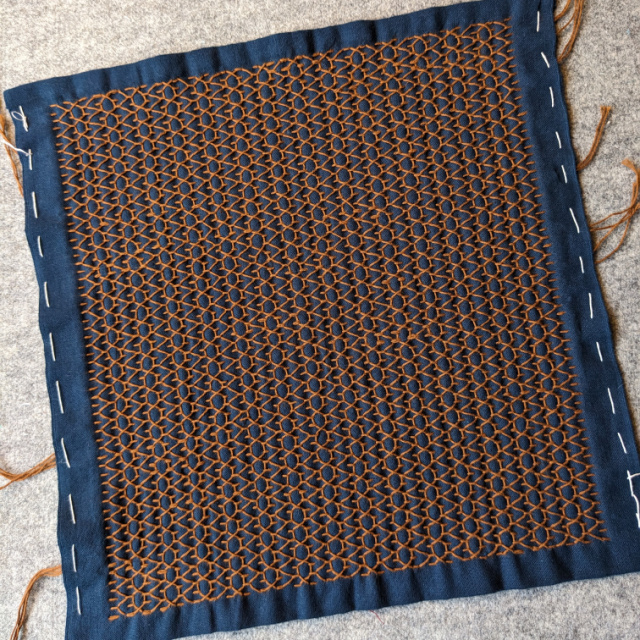Well, I hopped on this project train at a time when I was swamped with other things, but when I saw it I really loved it, so there's that. I'd recently finished the 24 Days of Sashiko, when I saw the hostess, Kazue @sashiko.lab post about her upcoming Coffee Fukin Club. What I knew was that the stitching would be done on navy sashiko fabric with brown sashiko thread. Not sooo different from what I'd just finished except with authentic supplies rather than quilter's cotton and embroidery floss. And I wanted to try it. So knowing I'd get a late start, I went ahead and ordered a supply kit from Japan.
What I learned from Kazue is that a Coffee fukin is a Hanafukin - a sashiko stitched kitchen cloth. A few years earlier, she made one for her husband and it’s been his favorite ever since. He always uses it when making coffee and that’s why she calls it a “coffee fukin.” It is woven with sashiko patterns on both(!) sides, which sounded really intriguing.
So I finally got started stitching at the end of the year, and it began with some pretty routine base stitches.
Once those were done, we began weaving on the back of the cloth with the blunt end of the needle. For being the back, it sure was beautiful! Basically, we were weaving with two different stitches. After I was done, I saw a stitch that was done incorrectly, but I left it since I couldn't find it next time I looked! Just proves this piece was handstitched, right?
So the weaving on the front side took a little longer, considering we were using four different weaving patterns. I definitely had to follow the chart to see what pattern to stitch next as I moved across the cloth, but each pattern became very familiar, which made it relaxing to stitch.
Though I wanted to note that there was a finicky part of this stitching, and it was hiding the thread ends. Near the edges, you could hide knots between the fabric layers, but in the middle, you needed to double-stitch on the back side. This became especially tricky when working on the front. It wasn't always easy to work your needle between layers without taking stitches where you didn't want them. Obviuosly it was manageable, but I always knew it would take a little extra time to finish with a length of thread and begin a new one.
Once the weaving was all done on both sides, threads got trimmed, and the perimemiter was stitched to secure the edges. Kazue gave us a good dozen different decorative stitch options, so I chose one that wasn't too time-consuming, but gave the piece a nice finish.
So ta da! I've made my first Hanafukin! 12" square, it has a wonderfully soft texture! I decided I'm going to use it more as a mat than a dish cloth. After I snapped the photo below, I placed it under all the coffee-making apparatus you see. If fits on top of the glass almost perfectly, and already, I'm enjoying seeing it there - beautiful but functional - as I make my morning coffee.
I'm pretty amazed that such simple stitching can create such beauty. I'm really glad I took advantage of the workshop Kazue offered, as I thoroughly enjoyed the stitching experience as well as creating this unique piece for use in our home.













It is really beautiful.
ReplyDeleteThanks so much, Gale!
DeleteIsn't that a beauty? I'm seriously thinking of ordering the kit too.
ReplyDeleteI'm still working on a sashiko project that began with the 24 Days of Sashiko, I turned it into a 'hannafukin' of my own design. I love the stitching in Sashiko the geometry of it makes a lot of sense to me, and then the intended usefulness of the projects is great. Thanks for sharing
It's beautiful and I'm intrigued by the combination of stitching and weaving. I would probably have a hard time using this as a dishcloth until I made a few hundred more of them. ;)
ReplyDeleteSuch a beautiful piece! I have a small sashiko piece I started awhile back, my first ever. I guess I need to get it back out and get stitching again. I don't think I will ever be able to do one as complicated as yours.
ReplyDeleteWhat a pretty piece. Interesting that you weave with the blunt end of the needle, but I understand why. Sashiko is very relaxing, and the outcome is beautiful.
ReplyDeleteThis is beautiful! I would like to touch it!! Very very nice!
ReplyDeleteWhat a beautiful piece of needlework. I never cease to be amazed at the inventiveness of the Japanese people in creating beauty with every-day items. Also, the low-contrast brown thread instead of white is especially appealing to my eye.
ReplyDeleteThank you, Carol! I totally agree, and the brown thread is part of what drew me in!
DeleteSuch a lovely piece! The patterns look intricate, and have so much texture. I'm guessing that the cloth sort of shrunk a little during the stitching process. You're using it just as it was intended, and that's great. Hope it will be okay to wash (by machine?) because if you're anything like we are, coffee and tea sometimes gets sloshed on the countertop. I bet you're planning to stitch another one, right?
ReplyDeleteOh wow, that is really beautiful stitching!
ReplyDeleteYou'll need to check out Shibori Dragon down in University Place just south of Tacoma. Becky has all the Japanese supplies! She has a website but the shop, oh my!
ReplyDelete